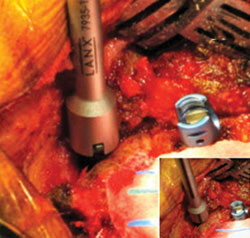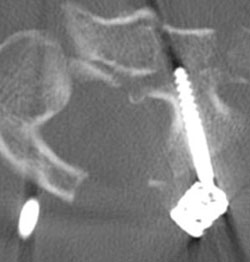Use of an extreme angle screw to reduce spinal deformities
The surgical management of unstable cervical or cervical-thoracic fractures related to trauma or cervical spondylosis includes anterior, posterior or combined approaches. For the posterior approach, there are several options for screw locations. For example, many surgeons select to use lateral mass screws in the subaxial spine (cervical levels three to seven).
At the C2 and C7 segments, one can place pedicle or translaminar screws. In the setting of fractures or instability near the cervical-thoracic regions, the construct may include upper thoracic pedicle screws (T1, T2 and/or T3). An unstable injury of the occipital-atlantal or atlantal-axial levels may require stabilization to the subocciptal bone with an occipital plate or C1 lateral mass screws, respectively.
This particular procedure can prove challenging as there are factors preventing the surgeon from efficiently and effectively placing one rod to include all screw tulips. These challenges include the close cranial/caudal location of adjacent screws, varied entry site locations for posterior instrumentation (medial/lateral), the different trajectories and pathways of these screws, and loss of standard anatomical landmarks and alignment from deformity. Also, further complicating rod placement, deformity can place the screw and its tulip at a single segment even further away from the natural rod location of the adjacent segments.
I have encountered this problem with approximating the C2 pedicle or laminar screws with an occipital-cervical or cervical rod, or with connecting and including the C7 screws with a cervical-thoracic rod to the upper thoracic pedicle screws. It is important to note that over manipulation or contouring of the rod to fit the placement of all screws may weaken the overall strength of the construct. Finally, it is absolutely necessary to restore a normal alignment, including cervical lordosis, while placing screws/rods. Outlier screws can make this difficult to achieve.
One option commonly considered to overcome the need for multiple screw placements is to place a side connector from a screw that is too lateral or medial compared to the existing rod location. Unfortunately, it takes extra time to place these side connectors: they require placement of extra instrumentation, and biomechanically, they are not as strong as direct fixation to the rod. For example, an offset connector to a C2 laminar screw is weaker biomechanically in flexion-extension compared to direct rod fixation of C2 laminar or pedicle screws. Another alternative is to use the maximal angle of the cervical-thoracic polyaxial screw to attempt to line up the tulip to the rod, but it may not have sufficient angulation, and many screws have biased angles without full 360° manipulation.
Polyaxial screw
A new option is the Vail Extreme Angle Turret Screw (Lanx, Inc.) which has helped me accommodate for differences in screw entry locations and deformities with a single polyaxial screw. It achieves 55° of angulation in all directions (110° cone) and up to 4.3 mm of medial/lateral rod offset. Unlike similar screw options, this has a true polyaxial cone of motion that is not limited by medial/lateral, cranial/caudal or other predetermined bias positions.
I select to use this extreme angle screw at the C1, C2, C7, T1 or T2 levels, and use the turret mechanism to place and fix the tulip at any angle necessary to line it up with the rod. (Figures 1 and 2). This screw is used interchangeably with the standard polyaxial screws placed at the subaxial cervical spine, and uses the same set screws, rods, connectors and instrumentation that most surgeons are accustomed to using.
|
|
Images: Gottfried ON |
The placement of this extreme angle turret screw is similar to any other cervical-thoracic polyaxial screw, but the technique for adjusting the screw to the appropriate angle is different. (Figure 1). The adjustment of the tulip angle and direction is performed using the special slot turner with or without the head turner. The screw housing pivots about the screw head in one plane, and it is necessary to align the notch in the slot turner with the ridge on the lower housing located below the tulip and above the screw. The notch and ridge features are always at 180° from the slot. This slot is indicated with solid laser-marked lines on the lower housing and slot turner.
Once engaged in the ridge, it is possible to rotate to the desired orientation. The maximal angulation occurs at 180° from the ridge or at the marked line. The upper housing rotates 360° as a standard polyaxial screw about the screw head using the turret head turner. The upper and lower housing may be rotated in tandem by sliding the slot turner straw over the head turner and repeating the aforementioned process. All subsequent steps follow standard technique, including rod preparation and placement, set screw placement, compression/distraction and final tightening.
|
|
Another function
I have found another benefit to this specialized screw. After placing it to the desired angle in a medial-lateral plane, I leave the slot/notch at 3 o’clock and 9 o’clock. This makes the polyaxial screw function as a fixed, monoaxial screw for maximal distraction and compression. In fact, the screw is locked in this position before the set screw is placed and tightened. For the standard polyaxial screw, part of the effort of distraction or compression is taken up by the polyaxial tulip and not the screw limiting the correction of the deformity. I have seen great restoration of cervical lordosis and alignment with this new screw and technique.
For example, I used this technique to maximally reduce kyphosis, and perched and splayed facets with compression of polyaxial lateral mass screws that were converted into fixed ones. In another case, I corrected a severe C2 fracture resulting in C1-2 instability and rotatory subluxation by placing the C2 turret screw to a monoaxial moment and pulling the screw to the rod in a balanced coronal plane. (Figure 2). Finally, after rod placement, I frequently compress screws while fixed in monoaxial plane on a lordotic rod to improve sagittal balance.
Overall, I find the Lanx Vail Extreme Angle Turret Screw helpful in correcting spinal deformities from trauma or cervical spondylosis because of its ease with rod placement without the need for over manipulation, the avoidance of side connector, improved compression, and its ability to restore normal alignment and maximize cervical lordosis. It also facilitates rod placement even for screws offset from the natural plane of the rod.
References:
- Benke MT, O’Brien JR, Turner AW, Yu WD. Biomechanical comparison of transpedicular versus intralaminar C2 fixation in C2-C6 subaxial constructs. Spine. 2011; 36:33-37.
- Deen HG, Birch BD, Wharen RE, Reimer R. Lateral mass screw-rod fixation of the cervical spine: A prospective clinical series with 1-year follow-up. Spine J . 2003; 3:489-495.
- Lindsey C, Deviren V, Xu Z, Yeh RF, et al. The effects of rod contouring on spinal construct fatigue strength. Spine. 2006; 31:680-1687.
- Mummaneni PV, Haid RW, Traynelis VC, et al. Posterior cervical fixation using a new polyaxial screw and rod system: technique and surgical results. Neurosurg Focus. 2002;12:E8.
- Oren N. Gottfried, MD, can be reached at Department of Surgery, Division of Neurosurgery, Duke University, Durham, NC 27710; email: oren.gottfried@duke.edu.
- Disclosure: The author is a paid consultant for Lanx. He has not received any funding for this report and does not have any financial interest in this product or any other Lanx product.



